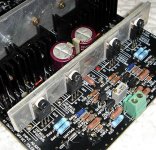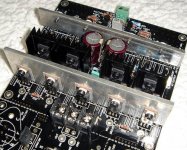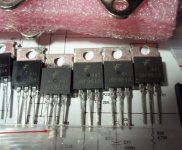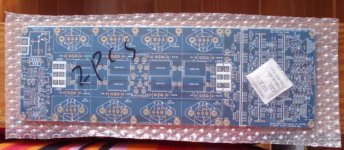Take the power supply section from the KSA-80 thread on this website and adjust the raw supply and zeners to run the KSA-100 main board and driver stage.
Hey, Thats my line! I would still use the higher frequency devices if the rest of the specs for them fit into place but the use of a one piece board and higher frequency devices is not going to allow them to be used to any higher a frequency than the circuit is designed for. There may be some benefit but not as great as you might think. I've actually has better luck with using the On Semi perforated emitter devices myself. MJ21193,94 and these only have a 4mhz bandwidth which is still way more than the circuit is going to operate at.
Mark
Geesh that regulator circuit is way more complex than the basic zener-follower listed in Krell PDF file. Whether it's really necessary is debatable; a three-stage zener-follower with properly calculated component values gave me totally flat DC even with its DC supply littered with 5V 50, 150, 1k and 10kHz squarewaves. I'll simulate it though and see how it compares.
Hi,
the follower has fairly good line regulation and comparatively poor load regulation.
The nearly continuous current draw of a ClassA input voltage amplifier would lead one, wrongly, into believing that good load regulation is not required.
But a ClassA stage draws a variable current from the supply rails when it is handling signal.
This puts signal modulation onto the supply rails.
I suspect this signal induced modulation is much better than all the other rubbish on the main supply rails. Even so there should be measurable improvement compared to no regulators.
I further suspect that a good feedback type regulator will produce even better dividends if the comparison were made.
Who is going to volunteer to do that for us?
the follower has fairly good line regulation and comparatively poor load regulation.
The nearly continuous current draw of a ClassA input voltage amplifier would lead one, wrongly, into believing that good load regulation is not required.
But a ClassA stage draws a variable current from the supply rails when it is handling signal.
This puts signal modulation onto the supply rails.
I suspect this signal induced modulation is much better than all the other rubbish on the main supply rails. Even so there should be measurable improvement compared to no regulators.
I further suspect that a good feedback type regulator will produce even better dividends if the comparison were made.
Who is going to volunteer to do that for us?
Good News! 6 Prototype boards are on the way. The last DFM was just about perfect and the couple of silkscreen problems that existed were automatically corrected by the PCB house's computer. I should have the boards next Friday, just about the time I should be getting back into town.
Attached is the final silkscreen as it will be made.
Mark
Attached is the final silkscreen as it will be made.
Mark
Attachments
Banned
Joined 2002
Mark A. Gulbrandsen said:A view from the other side......
I wonder how many are made ? Is this the first time y have seen this board or is this your actual board.
It is a very well designed board. I also prefer to use that type of output device myself and used it in the KSA-50 amp that I built. PWatts made room for two different kinds of fets on our board... the IR TO-220 type as you used and also for the ZVP/ZVN 2210.
If you make another run of boards please count me in for one set. Also we will eventually be making a large run of our DIY KSA-100 MK-2 boards if you need any of our configuration.
Shipping can be through regular post office.. I have ordered boards from China before... delivery takes about a month.
Mark
If you make another run of boards please count me in for one set. Also we will eventually be making a large run of our DIY KSA-100 MK-2 boards if you need any of our configuration.
Shipping can be through regular post office.. I have ordered boards from China before... delivery takes about a month.
Mark
Before anybody ask, the blank area between the predrivers and the drivers are to accommodate heatsinks for the predrivers if needed.
Actually I made provision for three different FET's, but not the TO220 types after we saw that they're very inferior in this application. I provided for DIP-4 (IRFD110/9110) since they're superior to the 510/951 in this regard. The other was TO-92 for the ZV3310A and 2210A ones, and the third SOT-223 for the G types. I personally would prefer the latter, but without proper tools they'll be a b*tch to remove if something breaks. I doubt whether matching will bring any worthwhile improvement, but hey, they're cheap and matching is easy.
As a matter of interest I managed to blow up Jozua's original MK2 KSA100 yesterday night just before I wanted to put the cover back on after an extensive service.. all the PNP output transistors and half the driver stage. Since I wanted to change the output transistors to MJ21193/MJ21194 anyway; I had to strip the whole damn thing. It's now lying gutted like a catfish on my workshop floor Hopefully it will be playing better than ever in a few days again.
Hopefully it will be playing better than ever in a few days again.
I also took a few measurements on my Audio Precision of both the Mk1 and the Mk2. Quite interesting, measurement-wise they're both good in certain areas. I'll try to make the graphs as small as possible to post here. However, the 50Hz ripple and noisefloor on both were higher than on the KSA50 clone I built for him last year.
Actually I made provision for three different FET's, but not the TO220 types after we saw that they're very inferior in this application. I provided for DIP-4 (IRFD110/9110) since they're superior to the 510/951 in this regard. The other was TO-92 for the ZV3310A and 2210A ones, and the third SOT-223 for the G types. I personally would prefer the latter, but without proper tools they'll be a b*tch to remove if something breaks. I doubt whether matching will bring any worthwhile improvement, but hey, they're cheap and matching is easy.
As a matter of interest I managed to blow up Jozua's original MK2 KSA100 yesterday night just before I wanted to put the cover back on after an extensive service.. all the PNP output transistors and half the driver stage. Since I wanted to change the output transistors to MJ21193/MJ21194 anyway; I had to strip the whole damn thing. It's now lying gutted like a catfish on my workshop floor
 Hopefully it will be playing better than ever in a few days again.
Hopefully it will be playing better than ever in a few days again.I also took a few measurements on my Audio Precision of both the Mk1 and the Mk2. Quite interesting, measurement-wise they're both good in certain areas. I'll try to make the graphs as small as possible to post here. However, the 50Hz ripple and noisefloor on both were higher than on the KSA50 clone I built for him last year.
Hi P,
sorry to hear of your mishap.
Hope the enforced upgrade makes it worth it.
How old are the caps in the 100s?
ESR goes up as they age (temp and other things).
As ESR rises the noise (both HF and ripple) passing the smoothing will get worse.
That could be the effect you are measuring.
sorry to hear of your mishap.
Hope the enforced upgrade makes it worth it.
How old are the caps in the 100s?
ESR goes up as they age (temp and other things).
As ESR rises the noise (both HF and ripple) passing the smoothing will get worse.
That could be the effect you are measuring.
Well the caps are all original and the Mk2 is a 1985 vintage, so they're 21 years old by now. Large Sprague ones. The Mk1 is a few years older and Krell still wanted to put their name on it, but I think they may be Mallory ones. If space permits I'll maybe try adding a PCB with 20000uF or so snap-in caps and a 1mH choke for improved smoothing and a KMA section at the bottom. Enough space in the Mk1 for that but the Mk2's packed too full I'm afraid.
I'm going in today to cobble the Mk2 back together, and I'll try to take some pictures of the thing.
One thing that struck me of the Mk2 (while it was still playing) was the low noise. That must pretty much be the lowest noise I ever heard on an amplifier that's not a class-D, and much lower than the Mk1. Very impressive indeed.
I'm going in today to cobble the Mk2 back together, and I'll try to take some pictures of the thing.
One thing that struck me of the Mk2 (while it was still playing) was the low noise. That must pretty much be the lowest noise I ever heard on an amplifier that's not a class-D, and much lower than the Mk1. Very impressive indeed.
There is a photo early on in the thread that shows the inside of the KMA-100... its very simle regulator and IMHO only supplied the front end with regulated power. There is but one heat sink right in the middle of the reglator board.
Full view KMA-100
Side view near regulator board
Mark
Full view KMA-100
Side view near regulator board
Mark
Mark A. Gulbrandsen said:IMHO only supplied the front end with regulated power.
Therefore the 2 smaller additional 100V electrolytic cans, on top of the 160.000uF quartet and 1200VA toroidal.
Therefore the 2 smaller additional 100V electrolytic cans, on top of the 160.000uF quartet and 1200VA toroidal.
Ha, What was that all about????????????
Mark
Jacco,
Even air in Europe is more expensive than over here in the States so the Krell's being more expensive is no surprise.
The proto boards have been shipped and should be in the office when I get back on Thursday or Friday. I also ordered the 1N5309's and the fet's from Mouser and they should also be there.
Is there any problem with me usng MJE15032/33 instead of the 15034/35 pair? I have a number of the first pair in stock at home....
I am also going to use MJ21193/94 for output devices. These worked extremely well in the KSA-50.
Mark
Even air in Europe is more expensive than over here in the States so the Krell's being more expensive is no surprise.
The proto boards have been shipped and should be in the office when I get back on Thursday or Friday. I also ordered the 1N5309's and the fet's from Mouser and they should also be there.
Is there any problem with me usng MJE15032/33 instead of the 15034/35 pair? I have a number of the first pair in stock at home....
I am also going to use MJ21193/94 for output devices. These worked extremely well in the KSA-50.
Mark
- Home
- Amplifiers
- Solid State
- Krell KSA 100mkII Clone



